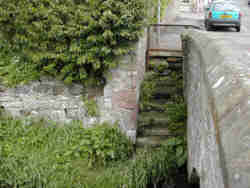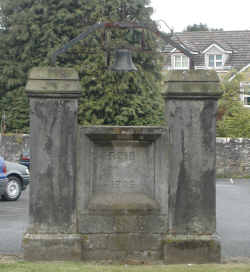
One name on a war memorial...
"13707000 Flight Sergeant George Thomson RAF Volunteer Reserve, 9 Squadron, Bomber Command (Deceased).
"This morning was the Wireless Operator on a Lancaster aircraft which attacked the Dortmund - Ems Canal in daylight on 1st January 1945. The bombs had just been released when a heavy shell hit the aircraft in front of the mid-upper turret. Fire broke out and dense smoke filled the fuselage. The nose of the aircraft was then hit an in rush of air, clearing the smoke, revealed a scene of utter devastation.
Most of the perspex screen of the nose compartment had been shot away, gaping holes had been torn in the canopy above the pilots head, the inter-com. wiring had been severed, and there was a large hole in the floor of the aircraft. Bedding and other equipment were badly damaged or alight; one engine on fire.
"F/S
Thomson saw that the gunner in the blazing mid-upper turret was unconscious.
Without hesitation he went down the fuselage into the fire and exploding
ammunition. He pulled the gunner from his turret and edging his way round
the hole in the floor, carried him away from the flames. With his bare
hands he extinguished the gunners burning clothing. He himself sustained
serious burns on his face, hands and legs.
"F/S Thomson then noticed that the rear gunners' turret was also
on fire. Despite his own severe injuries he moved painfully to the rear
of the fuselage where he found the rear gunner with his clothing alight
overcome by fumes and flames. A second time F/S Thomson braved the flames.
With great difficulty he extracted the helpless gunner and carried him
clear. Again, he used his bare hands, already burnt, to beat out flames
on a comrades clothing.
"F/S Thomson by now almost exhausted , felt that his duty was not yet done. He must report the fate of the crew to the captain. He made the perilous journey back through the burning fuselage, clinging to the sides with his burnt hands to get across the hole in the floor. The flow of cold air caused him intense pain and frost bite developed. So pitiful was his condition that his captain failed to recognise him.
Still his only concern was for the two gunners he had left in the rear of the aircraft. He was given such attention as was possible until a landing was made some 40 minutes later.
"When the aircraft was hit F/S Thomson might have devoted his efforts to quelling the fire and so have contributed to his own safety. He preferred to go through the fire and succour his comrades. He knew that he would then be in no position to hear or heed any order which might be given to abandon the aircraft. He hazarded his own life in order to save the lives of others. Young in years and experience, his actions were those of a veteran.
"Three weeks later F/S Thomson died of his injuries. One of the gunners unfortunately died, but the other owes his life to the superb gallantry of F/S Thomson whose single courage and self sacrifice will ever be an inspiration to the service."
NB. This information is copied from the records in the Public Record Office, Kew, London. I can not explain the difference in the spelling of his surname.
Commonwealth War Graves Commission — George Thompson VC.
Long before the advent of public water supplies the towns people drew their water from the nearest source, the people of Milnathort drew theirs from the Queich Burn, which runs through the town on its way to Loch Leven.
Tucked in beside the North Street bridge is a set of well-worn steps down to the burn providing a rare insight into this long forgotten daily ritual.
 The
steps down to the Queich
The
steps down to the Queich
All that is left of the Reid Memorial school, built in 1895, is the old school bell, which was mounted on a plinth following the schools' demolition. The bell can be seen to the right just off the A91, Stirling Road heading west.
 School bell
School bell